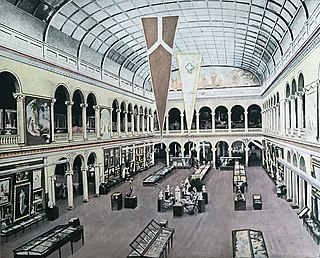Related Research Articles

University of the Sciences in Philadelphia, previously Philadelphia College of Pharmacy and Science (PCPS), was a private university in Philadelphia, Pennsylvania. On June 1, 2022, it officially merged into Saint Joseph's University.
The Royal Pharmaceutical Society of Great Britain (RPSGB) existed from its founding as the Pharmaceutical Society of Great Britain in 1841 until 2010. The word "Royal" was added to its name in 1988. It was the statutory regulatory and professional body for pharmacists and pharmacy technicians in England, Scotland and Wales. In September 2010, the regulatory powers of the Society were transferred to the newly formed General Pharmaceutical Council (GPhC). The RPSGB became the Royal Pharmaceutical Society (RPS) at that time and retained its professional leadership role; the "Great Britain" part of the name was dropped for day-to-day purposes.

Apothecary is an archaic English term for a medical professional who formulates and dispenses materia medica (medicine) to physicians, surgeons and patients. The modern terms 'pharmacist' and 'chemist' have taken over this role.

The American Pharmacists Association, founded in 1852, is the first-established professional society of pharmacists in the United States. The association consists of more than 62,000 practicing pharmacists, pharmaceutical scientists, student pharmacists, pharmacy technicians, and others interested in the profession. Nearly all U.S. pharmacy specialty organizations were originally a section or part of this association.

The history of pharmacy in the United States is the story of a melting pot of new pharmaceutical ideas and innovations drawn from advancements that Europeans shared, Native American medicine and newly discovered medicinal plants in the New World. American pharmacy grew from this fertile mixture, and has impacted U.S. history, and the global course of pharmacy.

Lucy Everest Boole FRIC was a British chemist and pharmacist who was the first woman to research pharmacy in England. She was the first female professor at the London School of Medicine for Women in the Royal Free Hospital, and the first female Fellow of the Royal Institute of Chemistry.
Jean Kennedy Irvine was a pharmacist from Hawick, Scotland and the first woman president of the Royal Pharmaceutical Society of Great Britain.
Zada Mary Cooper was an American pharmacist and educator.
Elizabeth Gooking Greenleaf was the first female apothecary in the Thirteen Colonies. She is considered to be the first female pharmacist in the United States.

Susan Hayhurst was an American physician, pharmacist, and educator, and the first woman to earn a pharmaceutical degree in the United States.

Ida Hall Roby was first woman to graduate from the Pharmaceutical Department of the Illinois College of Pharmacy, Northwestern University, and the only woman pharmacist in Illinois at the end of the 19th century.
Elizabeth Marshall was an American entrepreneur who became the second female pharmacist in the United States.
Mary Munson Runge was the first female, the first African American, and the first employee community pharmacist to be elected president of the American Pharmacists Association (APhA).
The National Association of Women Pharmacists was founded in London on 15 June 1905, following discussions between Margaret Elizabeth Buchanan and Isabella Skinner Clarke. Early meetings were held at Clarke's home. Membership was restricted to those who had passed the major or minor examination and 50 women joined immediately. By 1912 Buchanan claimed that practically all women practicing pharmacy were members. Buchanan served as its president at one point.
Margaret Elizabeth Buchanan was a British pharmacist and pioneer of women in pharmacy.
Frances ("Fanny") Elizabeth Deacon (1837–1930) was an English chemist and druggist who was the first woman to qualify after the 1868 Pharmacy Act, which made registration with the Pharmaceutical Society of Great Britain (PSGB) compulsory in order to work as a pharmacist.

Hope Constance Monica Winch was an English pharmacist and academic.

Elsie Higgon was the first Joint Secretary of the (National) Association of Women Pharmacists; researcher for King's College, the British Medical Journal and the British Pharmaceutical Codex; Lecturer in Chemistry at Portsmouth Municipal College; proprietor pharmacist of two businesses in Hampstead, proprietor of the Gordon Hall School of Pharmacy for Women in Gordon Square, and a supporter of the suffrage movement.
References
- ↑ USA (2009). "The global pharmacy workforce: a systematic review of the literature". Human Resources for Health. Ncbi.nlm.nih.gov. 7: 48. doi: 10.1186/1478-4491-7-48 . PMC 2706790 . PMID 19545377.
- ↑ Wright, Susan (2005), The Civil Rights Act of 1964: Landmark Antidiscrimination Legislation, The Rosen Publishing Group, ISBN 978-1-4042-0455-3
- ↑ "Transcript of Civil Rights Act (1964)". Retrieved July 28, 2012.
- ↑ See generally, "Women's Human Rights", 1998, Human Rights Watch (available online).
- ↑ Rayner-Canham, Marlene; Rayner-Canham, Geoffrey (2008). Chemistry Was Their Life: Pioneering British Women Chemists, 1880–1949. Imperial College Press. p. 398. ISBN 978-1-86094-987-6.
- ↑ Naumann, Rolf (1953). "Anna, Kurfürstin von Sachsen". Neue Deutsche Biographie. Retrieved 2016-10-21.
- ↑ "'Sex In the City' tour: The knights and their ladies of the night". The Malta Independent. 25 March 2007. Archived from the original on 6 December 2016.
- ↑ Levertin Alfred, Schimmelpfennig Carl Fredrik Vilhelm, Ahlberg Karl, red (1910-1918). Sveriges apotekarhistoria från konung Gustaf I:s till närvarande tid. Bd 1, Stockholms stad, Stockholms län, Uppsala län, Södermanlands län, Östergötlands län, Jönköpings län, Kronobergs län. Stockholm: Ernst Westerbergs boktr.
- ↑ Oakes, Rensselaer Allston (1905). Genealogical and Family History of the County of Jefferson, New York. Higginson Book Company. p. 241. Retrieved October 31, 2016.
- 1 2 Henderson, Metta Lou; Worthen, Dennis B. (March 8, 2002). American Women Pharmacists: Contributions to the Profession. CRC Press. p. 2. ISBN 978-0-7890-1092-6 . Retrieved October 31, 2016.
- ↑ "Susan Hayhurst". American Journal of Pharmacy. Philadelphia College of Pharmacy and Science. 83: 32–39. 1911. Retrieved November 29, 2016– via Google Books.
- ↑ "Susan Hayhurst, pioneer female pharmacist, circa 1889". ExplorePAhistory.com. Retrieved November 29, 2016.
- ↑ Henderson, Metta Lou; Worthen, Dennis B. (March 8, 2002). American Women Pharmacists: Contributions to the Profession. CRC Press. p. 10. ISBN 978-0-7890-1092-6 . Retrieved November 29, 2016– via Google Books.
- ↑ Anyssa Garza (2018-05-10). "Happy Mother's Day to Women Pioneers in Pharmacy". Digital Pharmacist. Retrieved 2018-12-31.
- ↑ "Jacobi, Mary Putnam, 1842–1906. Papers of Mary Putnam Jacobi, 1851–1974: A Finding Aid". oasis.lib.harvard.edu. Archived from the original on 2018-04-25. Retrieved 2018-04-25.
- ↑ The Pharmaceutical Journal11 APR 2019. "Seven women pharmacists entered into the Oxford Dictionary of National Biography | News". Pharmaceutical Journal. Retrieved 2019-04-11.
{{cite web}}: CS1 maint: numeric names: authors list (link) - ↑ The Pharmaceutical Journal11 APR 2019. "Seven women pharmacists entered into the Oxford Dictionary of National Biography | News". Pharmaceutical Journal. Retrieved 2019-04-11.
{{cite web}}: CS1 maint: numeric names: authors list (link) - ↑ Rayner-Canham, Marlene; Rayner-Canham, Geoffrey (2008). Chemistry Was Their Life: Pioneering British Women Chemists, 1880–1949. Imperial College Press. p. 402. ISBN 978-1-86094-987-6.
- ↑ Fox, Irving P. (1915). "The Spatula - Google Books" . Retrieved 2017-03-18.
- ↑ Henderson, ML; Worthen, DB (2004). "Cora Dow (1868–1915) - pharmacist, entrepreneur, philanthropist". Pharm Hist. 46 (3): 91–105. PMID 15712452.
- ↑ "Cincinnati News, Sports and Things to Do | Cincinnati Enquirer". The Enquirer. Archived from the original on 2014-02-28. Retrieved 2021-09-02.
- ↑ "Looking back at 175 years of the Royal Pharmaceutical Society". 2016-04-15. Retrieved 2018-03-16.
- ↑ "USF Health News African American History Month: Seeing the past in today's health professions - USF Health News". Hscweb3.hsc.usf.edu. 2016-02-26. Retrieved 2019-03-14.
- ↑ "Woman's Distinction". The Glasgow Herald. June 5, 1947. Retrieved 23 November 2014.
- ↑ Stevens, Catherine M. C. Haines with Helen M. (2001). International women in science : a biographical dictionary to 1950 . Santa Barbara, Calif. [u.a.]: ABC-CLIO. p. 144. ISBN 978-1-57607-090-1.
- ↑ "Jean Kennedy Irvine". rpharms.com. Royal Pharmaceutical Society. Retrieved 23 November 2014.
- ↑ "Irvine, Jean Kennedy (c. 1877–1962)". www.encyclopedia.com.
- ↑ "Women in pharmacy: Key dates in history | AJP". ajp.com.au. 2 September 2016. Retrieved 2018-03-16.
- ↑ Chemist and Druggist: The Newsweekly for Pharmacy. Benn Brothers. 1894.
- ↑ Inger Dübeck: Kvinders retlige stilling. I Den Store Danske. Hentet 7. october 2015
- ↑ "Anna Louise James". Cypresscemeteryosct.org. Retrieved 2018-01-18.
- ↑ Elizabeth J. Normen (27 January 2014). African American Connecticut Explored. Wesleyan University Press. pp. 253–. ISBN 978-0-8195-7400-8.
- ↑ Royster, Jacqueline Jones (2003). "Ella Nora Phillips Myers Stewart." Profiles of Ohio Women, 1803 –2003. Athens, Ohio: Ohio University Press. ISBN 978-0-8214-1508-5. p. 97.
- ↑ "Ella Stewart." Contemporary Black Biography. Vol. 39. Detroit: Gale, 2003. Accessed via Biography in Context database, 2016-07-02. Available online via Encyclopedia.com.
- ↑ "A trip back in time for commemoration". 2012-04-11. Retrieved 2018-03-16.
- ↑ "KUZEY KIBRIS TÜRK CUMHURİYETİ NDE ECZACILIK VE ECZACI PROFİLİ - PDF Ücretsiz indirin". docplayer.biz.tr. Retrieved 2021-11-04.
- ↑ Metta Lou Henderson; Dennis B Worthen (8 March 2002). American Women Pharmacists: Contributions to the Profession. CRC Press. pp. 120–. ISBN 978-0-7890-1092-6.
- ↑ admin (2014-01-08). "Mary Munson Runge 1928 ~ 2014". Kappa Epsilon. Retrieved 2019-04-11.
- ↑ "Little Known Black History Fact: Mary Munson Runge". Black America Web. Interactive One, LLC. 18 November 2016. Retrieved 7 November 2017.
- ↑ "Obituary". Marianas Business Journal. 2010-05-23. Retrieved 2022-11-03.
- ↑ "Just the Right Medicine - Solomon Times Online". SolomonTimes.com. Retrieved 2022-05-20.
- ↑ "Adjuntas" (in Spanish). 17 September 2014. Retrieved 2021-11-13.